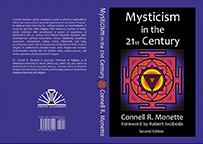Mysticism in the 21st Century, 2nd Edition
An interview with Dr. Connell R. Monette
Associate Professor of Religion in the School of Humanities and Social Sciences and Mohammed VI Library Associate Director at Al Akhawayn University in Ifrane, Morocco.
A mystic tradition can be considered a path or school of spirituality in which ones seeks a direct, personal experience of the Divine Presence, in whatever form that may be without barriers or intermediaries. Within the academic text book, Mysticism in the 21st Century (2nd Edition), Dr. Monette examines eight contemporary spiritual movements: Introduces Gnaoua from African Traditional spiritual origins, Shambhala as as an example of Buddhist tradition. Ecclesia Gnostica Aeterna as an example of contemporary Gnostic tradition. Order of Nine Angles on the Hermetic tradition, Boutchichia Tariqa on Sufism, International Nath Order on the Tantric tradition, Primal Craft on Witchcraft, and Bhakti, Rune, and Shadow from the spiritual practices within Yoga,
In my video interview with Dr. Monette, we discuss Mystism in the world, academic institutions and of those who helped infuse this mystic academic textbook.

Dr. Connell R. Monette is Associate Professor of Religion in the School of Humanities and Social Sciences and Mohammed VI Library Associate Director at Al Akhawayn University in Ifrane, Morocco. He holds a Ph.D. in Medieval Studies from University of Toronto, and his major areas of research are medieval religion and literature. He is the author of Mysticism in the 21st Century (2013) and The Medieval Hero (2nd ed. 2012), and a past contributor to the Journal of Indo-European Studies, The International Journal of Euro-Mediterranean Studies, Comparative Islamic Studies, and Islamic Horizons. He currently lives in Ifrane with his wife Fatiha and his children Miriam and Adam.
To read up on the previous interview with Dr. Monnette visit : http://www.monamagick.com/media/mysticism-in-the-21st-century/
A short interview with Dr. Monette on Mysticism in the 21st Century, 2nd Edition:
Congratulations on this second edition Dr. Connell! In the first book, you introduced Mysticism in the 21st Century… Many felt you covered quite a bit, hasn’t everthing been presented from a scholastic standpoint or is there an admittance within the academic community that theres so much more to uncover?
Many thanks for the congratulations! The field of Religious Studies is growing each year, as more and more academics become interested in territory that we’re only just discovering, or in new angles to traditional problems or interpretations. Even when I was an undergraduate student at University of Ottawa, the religious studies faculty was undergoing a shift from being largely composed of aging Catholic priests, to a new generation of Wiccan practitioners. Needless to say, the new faculty introduced new courses into the catalog, and so you could take courses on “New Religious Movements” or “Witchcraft and the Occult” with people who were not just teaching about mysticism — they were actually practicing it too. And this shouldn’t be surprising, any more than one is surprised by having a Buddhist teaching “Buddhism Today”, or a Christian teaching “Christian History”. So mysticism is being increasingly studied, and probably with greater sensitivity today than in the early 20th century.
In our first interview I voiced my opinion “Religion itself, and spirituality, is something to be experienced and not read”. You shared that given some paths require stern practices of devotion, as a compromise – observing though various available credible tools was not only convenient but economical. In either case, have you seen a change in tolerance through the awareness you brought forth within the 1st edition of Mysticism in the 21st Century from your students and what you know of your readers?
This is a really good question, and it relates directly to HOW we study religions. Ten or twenty years ago, the study of religion at university was limited to what students could read in books, or could observe in their immediate environment. So if you were studying in North America or Europe, you could read about world religions, but unless you lived in a major urban center, you wouldn’t be able to visit any of the religious holy places related to the traditions being studied, especially for minority religious traditions or movements. But technology has changed rapidly in the last several years, and YouTube alone has hundreds of hours of video and audio recordings which cover a wide range of religious practices. So in addition to their textbook readings about religious traditions, students can now directly observe those traditions, which leads to a much better understanding of their practices and beliefs. It is one thing to read a textbook description of a wedding ceremony, but it is entirely different to witness the ceremony, and to hear the music, and see the images, and the colors. Speaking broadly, education leads to understanding, and understanding leads to tolerance. I think that the students who used the textbook in my class gained a greater knowledge of some of the world’s spiritual traditions, and that is certainly an important step towards religious tolerance and community building.
When we last spoke you mentioned expanding upon Sufism, especially spiritual traditions native to Morocco so what inspired you to the other areas of spirituality which wasn’t included before?
 To be honest, my students get the credit for suggesting the various subjects. As a class exercises some 4 years ago, I asked them to identify traditions that they wanted to better understand in an upcoming courses, and so they compiled a list of mystical traditions. Some were generally Islamic (Sufism, Gnaoua), and others were from other religious or philosophical systems. Next, I contacted colleagues in the US and Canada who teach contemporary religion, and they in turn recommended a short list of potential consultants. I wrote to the various consultants, and the current eight chapters represent the various groups that were willing to collaborate in helping to draft a short summary of their traditions, their beliefs and practices, their origin (if known), and where they expected to be in the next fifty years. Working on these different traditions was a really interesting experience for me, as my academic training was in medieval studies, where these traditions are living systems. So the collaboration with leaders from the various traditions was a great help in making sure that my description of them was something that members of those traditions could identify with.
To be honest, my students get the credit for suggesting the various subjects. As a class exercises some 4 years ago, I asked them to identify traditions that they wanted to better understand in an upcoming courses, and so they compiled a list of mystical traditions. Some were generally Islamic (Sufism, Gnaoua), and others were from other religious or philosophical systems. Next, I contacted colleagues in the US and Canada who teach contemporary religion, and they in turn recommended a short list of potential consultants. I wrote to the various consultants, and the current eight chapters represent the various groups that were willing to collaborate in helping to draft a short summary of their traditions, their beliefs and practices, their origin (if known), and where they expected to be in the next fifty years. Working on these different traditions was a really interesting experience for me, as my academic training was in medieval studies, where these traditions are living systems. So the collaboration with leaders from the various traditions was a great help in making sure that my description of them was something that members of those traditions could identify with.
You know my next question then… you brought back a few paths of spiritually back in this 2nd Edition such as Primal Craft, is there something you are aim to make others aware to?
Well ideally, I hope that each edition of the book maintains the same chapters and continues to grow. The first edition was five chapters, and this new second edition is eight chapters. The original five chapters are there (updated), and there are three new chapters. The book is a good hundred pages longer than the original edition, and this edition includes a Conclusion. My friend and colleague Brian Seilstad (currently doing his Ph.D. in Education at Ohio State University) remarked that the first edition didn’t have a conclusion that drew the connections between the traditions, and so this second edition has a Conclusion that helps to make some of the parallels evident, as wells as the differences.
So, to return to your original question on that I would like to make students aware of, it’s religious diversity. There are so many different spiritual traditions in the world today, and in the current generation of information, people can easily research and discover traditions that they may not have access to in their hometown. All of the traditions in Mysticism in the 21st Century are deeply concerned with making the world a better place, or at least enhancing their practitioners’ experience of the world – so how they do this is very important for students of religious studies to understand.
I find your “Notes” section of this book to be really intriguing… somehow I feel that there is a lot more to be said regarding your quest to share this knowledge with everyone? For the sake of balance, would you be willing to include something for the record not written in the book for everyone to walk away with?
If there is one common thread to all the traditions in Mysticism, it is the shared conviction that our day-to-day experience of the world is obscured by confusion, ego, and illusion. Whether someone is a Sufi, a Yogi, a Tantric, a Hermetic, or a student of whatever craft or tradition, all mystics hold that there is a higher or reality or state-of-being, and that people can learn to tap into that reality/state in order to draw strength and inspiration to empower their day-to-day experience of the “normal” world. People who practice these traditions will tell you that their lives are improved through their practices, and that they can experience a higher state of being (briefly at least) – and that is a very positive thing in general terms. That is not to say that these traditions agree on what a higher state of being is, or what the higher reality looks like, or how we should get there. Yet at least they would agree that human spirituality should not be a dry and tasteless thing – and if our personal experience of the sacred were dry or tasteless, than at least Mysticism shows that there are different traditions and different practices which may be of interest to the reader.
Credits and Links:
Mysticism published by Sirius Academic Press
Purchase Mysticism in the 21st Century, 2nd Edition at Amazon
Visit Al Akhawayn University
Dr. Robert Svoboda
Purchase: Mysticism in the 21st Century, 2nd Edition
http://www.barnesandnoble.com/w/books/1117442454?ean=9781940964102
AFRICAN TRADITIONAL: The Gnaoua
BUDDHISM: Shambhala
http://www.shambhala.org
GNOSTICISM: Ecclesia Gnostica Aeterna
http://www.kosmic-gnosis.org
HERMETICISM: The Order of Nine Angles
SUFISM: The Boutchichia Tariqa
http://www.sufiway.net
TANTRA: The International Nath Order
http://www.mahendranath.org
WITCHCRAFT: Primal Craft
http://www.PrimalCraft.com
YOGA: Bhakti Yoga, Rune, Shadow
http://www.iskcon.org
http://www.rune-gild.org
http://www.shadowyoga.com
To receive notifications for the updates on upcoming interviews, newsletters and other announcements, please subscribe:



